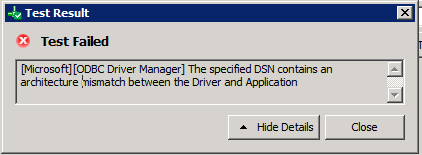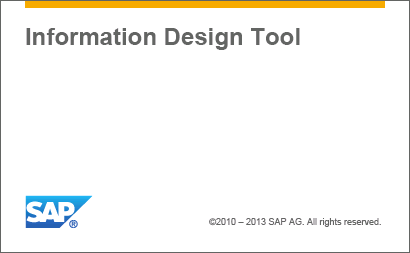I’ve been using Designer since my BusinessObjects career began in 2003 with version 5. Designer hasn’t changed much in that time, although derived tables and index awareness were added in version 6.5, restriction sets were improved in XI R1, and smart measures added to XI 3.x. At the recent 2009 SAP BusinessObjects User Conference, SAP indicated that the next major release of BusinessObjects Enterprise (code named Aurora and headed our way Q4-2010) will integrate Data Federator. We’ve been promised that future versions of Designer will assume all of the capabilities of Crystal Reports Business Views so that semantic layer can be retired in favor of the universe, and Data Federator could certainly make that possible. And as with all other BusinessObjects products, it’s a given that adding new SAP-centric features is at the top of the priority list. But how about some desperately needed usability improvements? I humbly offer the following list of recommended enhancements.
Disclaimer: Some of my friends were able to sign an NDA and check out Designer XI 4 at the recent SAP BusinessObjects user conference. However, I was not one of them. So I have no idea if any of the ideas below will actually appear in the next release. But with another year before the product is shipped, there’s still time to code some of these up… 😉
Usability Enhancements
- A read-only field on the object properties tab that displays the class hierarchy for the object (ex. class namesub-class namesub-class nameobject name). This field should make it easy to cut and paste from Designer to other applications.
- Ditto for the class properties
- The ability to use the standard Windows shortcut CTRL-A to “select all” of the contents of any field in the object properties
- A spacer object that can be inserted into large classes to indicate related items. Many developers resort to kludgy objects with hyphens to accomplish this feature. Sometimes subclasses just aren’t an option (or requirement). In Web Intelligence, the spacer object should have a small icon to collapse/expand the objects from the spacer to the next spacer (or end of class).
- An enhancement to the integrity checker that warns when a measure object does not have a database aggregate function in the SELECT clause. Should be a warning, not an error, because some folks (sigh) actually like measures w/o database aggregates.
- An object comment editor, with a filter button to show only classes and/or objects that do not have comments.
- A faster way to grab an object’s SQL than navigating to the object Properties tab, clicking on the Edit button for the List of Values (LOV) and viewing its SQL.
- Move the Refresh Structure menu option from View to Tools. I know it’s been there for years, but “View” implies that the menu choices don’t affect the universe but only it’s display in the application. Refresh Structure most certainly alters the universe and should be classified as Tool. Add a toolbar button while you’re at it.
- Put some space on the toolbar between the helpful List Mode button and the evil Arrange Tables button. It’s too easy to hit the latter and I generally prefer to not use it at all. And per my friend Andrew Koller, why can’t we undo the effects of the Arrange Tables button, anyway?
- Allow user to right click in schema window and zoom in to exactly that spot (or table, if selected)
- Allow user to right click in schema window and center the display at that spot (or table, if selected)
- Allow paste from clipboard to text blocks in the schema view
- Allow designers to create “groups” of tables, similar to groups of objects in Microsoft Visio.
- In addition to placing comments on the schema itself, allow comment blocks to be tagged to tables, joins, or table groups so that comment blocks always remain associated with the appropriate object(s), regardless of how they are arranged
- Allow designer to assign a unique color (not just Windows grey) to individual tables or groups of tables (Should these colors also be applied, maybe as an option, to object names?)
- Allow for multiple fonts, block colors, and block outlines for text blocks in the schema view. These enhancements will facilitate better documentation
- Variable zoom, please? Maybe a nice slider instead of the current drop-down with limited settings?
- When I right click on a table and choose View Associated Objects, please pop up a box to tell me the table is unused. Currently, the universe pane stays stuck on its previous object, which misleads me into thinking that it belongs to the table.
- View Associated Tables should cause the universe window to scroll, not jump. Currently too easy to lose ones place when seeing where various objects in a class come from. The current version simply “jumps” to the correct (mostly) location and it’s easy to get lost in a larger universe.
- If I right click on an object and choose View Associated Table and that table is on the screen, do not center on the table if the table is already on the screen but just highlight the new table. Very confusing as it alters the user’s frame of reference. Or, the screen should re-center by gently scrolling to the new position, so the designer can maintain his or her sense of direction in the universe.
- Right click on class name and choose View Associated Table(s), similar to what’s available for objects. This option would help a developer clearly identify all tables utilized by the class. Like my other suggestions, screen should “gently” center/resize to help designer maintain their frame of reference. Universe window should scroll out slowly to show all tables.
- Similar to the properties tab in Web Intelligence, add toolbar buttons to the top of the universe pane that close all classes simultaneously and open all classes simultaneously. Also, could we filter by qualification (dimention, detail, measure), data type (char, integer, date, long)?
- Add toolbar button to filter hidden objects, as many times these are candidates for deletion.
- The ability to find joins without defined cardinality (suggested by James Halligan)
- A wizard to construct @prompts (suggested by James Halligan)
- Better date handling (suggested by Josh Fletcher)
- How about adding a tabbed interface so that unconnected portions of schema could be stored on separate tabs for easier maintenance. Or, if that’s facilitating too much poor design, how about a right click option that allows me to right click on either a bunch of objects or tables and choose to build a new universe from them? Copy objects wizard would have options to control how many tables are brought over.
- Back to the tabbed interface… How about a separate tab for “original” tables that are aliased but not used, per best practice. And a wizard on the tools button that identifies tables that have been aliased elsewhere, replaces those tables with an alias, and recodes any dependent objects?
- And a recycle bin tab… With a wizard that identifies unreferenced tables (not part of a valid join path) and moves them there.
- Just like a road atlas, and instead of rulers in applications like Microsoft Word, allow designers to turn on a grid of letters and numbers. Right clicking on an object’s properties should tell me that the table is on the “map” at B6, etc. This “map” would also be helpful for those of us who have to print large universes and tape multiple sheets of paper together.
- Regular expression support for Find and Replace
- When Find locates an object in a large classes, the item identified by the Find/Replace function is at the bottom of the screen and partially obscured by scrollbars. Could we see the whole object, please?
And while we’re at it, a few related improvements in the other tools…
- Improved abilities in the Web Intelligence and other query panels to get the class hierarchy, object SQL (not just query SQL) and data lineage. Although it’s a bit tech-centric for a user-centric tool, some customers put this technical information where the non-technical help text is supposed to go. Having separate containers, and client tools that access them, makes everyone happy.
- Allow version control history for each object, without totally cluttering the interface (might be challenging). This data should also be available through Metadata Manager
- Add reporting capability to Metadata Manager that searches all universes on a given universe connection and identifies multiple universes that point to the same underlying SQL but have different names (consistency checker). Should have option to determine if aliases are included or not.
So what would you like to see in the next version of Designer? Feel free to post a comment.
- Allow table groups to be named. Still thinking about what an end-user might do with such a name…




Hi,
what about the ability to:
1.make an Or operator in the securitygroup available.
2.dynamic SQL – an object can behave different in the
where clause than the select clause (good for measures)
3.build in documenter.
4. Warning about date,measure,Id’s objects with LOV.
5.mark recently changed objects.
6.replace SQL for specific object type.
7.view associated context.
8.search by join type.
9.Show agg_aware in metric view
10.isolate contexts area so we can focus just in it.
11.Dynamic SQL:
if specific object is chosen, other object, where clause, join is created with it in group/user level.
12.Show class/object for specific group (automatically other groups can’t see it) via – use the “Yes” as an option to disable objects.
13.A real check integrity for joins & objects with no “holes” while parsing one.
14.Object–>view associated reports.
15.replace table name, object type, name at a specific folder.
16.Macro like in Excel that will record simple actions that always repeat.
17.mark the junctions that create the loop.
18.Build in Complex time Hierarchy (last day of month, first Quarter & ctr.)
19.Summary : how many duplicate objects by SQL.
Great list…
You better be careful, you might land a job in Business Objects R&D!!
Great list, Dallas 🙂
Now, I am after new features, such as:
– True GLOBAL variables (instead of smart measures). GLOBAL variables are defined at the universe level, but calculated in a 2-step approach within the report. This way one can also create objects spanning multiple universe contexts.
– Feature to support creation of time-sliced measures (YTD, MTD, Rolling 12 Months, etc.) for all major DBMS (MS SQL Server, Oracle, IBM UDB, Teradata).
20.build in LOV dummy_tables lists for objects that usually bring them from big tables.
21.clarifying about section 7 :join –> view associated context
22.define drill in group/user level
23.get all info about table,join,object,condition when
right clicking on it (join–>tables,objects,context & ctr’)
24.the ability to define full outer without changing the ANSI92 prm. in the universe level.
Two years ago I attended a focus group for Designer at one of the conferences, two items I brought up there still have yet to be implemented, yet everyone thought they were good ideas… lets add these two to your list:
1) The ability to press ENTER within an object window and not have it close but instead insert the line feed. Why must we use Notepad to help create our complex SQL statements so they are legible!
2) The ability to mark an object as “Ignore this object when checking universe”. How many times do I need to be told my “Company Name” object fails parsing? Sure I can put the company name in a database in a tiny table but ohh wait I can’t.. I’m not the DBA! There are lots of uses for basic text only objects that will never parse correctly.
25.Import the Meta Data of Tables,Columns when iporting the Tables.
26.Agg_aware – folder to folder restrictions & not just
table to folder.
27.Support Blob & pictures type fields.
28.Date LOV’s with no time portion.
29.Auto udpate in Universe Structure when table name,format is changed in the DB.
30.Build in Meta Data Dictionary Import (via business name of the column).
31.add option to aliases & contexts &shortcut join :table mapping:when user drag objects that creates the loop,send the SQL to a table that solves “the loop” by the designer defintion.
32.ability to define the order of joins in Queries:
a–>c–>b,very important in some cases you want a lookup table will take effect.
I wish the designer has some facility for TIME SERIES Analysis Functions similar to the ones found in OBIEE Semantic layer eliminating the need to create and store complex time-based reporting tables.
Function like TODATE and AGO functions found in OBIEE semantic layer (siebel analytics).
I wish BO universe designer has this sort of functionality which is present in OBIEE semantic layer. where I do not need to create and store time-based reporting tables.
Regards
Ishaq
In regards to “True GLOBAL variables”. I believe this is a much needed addition to the Universe. Especially if the Universe is intended to replace the Crystal Report Business View. With that said, they would need syntax that supports Web Intelligence, Desktop Intelligence and Crystal Reports.
I would also like to see full support for cascading list of values for Crystal Reports.
I would like the ability to use the connection through my Business Objects server that I am already am connected to rather than having to install and duplicate the connection middle-ware on my PC. I have encountered many problems due to a universe that works differently on a developer’s PC than it work on the Business Objects server because of middle-ware versions, default databases, firewalls, etc.
33.Numbered joins,so whem you manage joins in contexts ,you will kmow exactly which joins to add without the limitations of the context view panel.
34.Manage Join type in Group/User level (can give us a lot of new row level security options).
35.redo option
36.be able to recognize the objects that where deleted
and causing the massage :”some objects have been removed”…
37.use index awareness without the primary key definition.
i just wannt to save joins not to index my values.
I will forward this quite extensive list to the Dev team of Information Design Tool 🙂
It would be great to have an updated one when when BI 4.0 is out
Regards,
John
John, I’m really anxious to do it once the GA software is available. For example, the Information Design Tool (IDT) allows different colors to be assigned to tables, which was a feature request that appeared on my original list. I’m really excited about the new tool and it’s “clean sheet of paper” approach to designing universes.
We’ve been waiting for feedback from customers concerning IDT for a couple of years now. I hope the GA will be soon 🙂